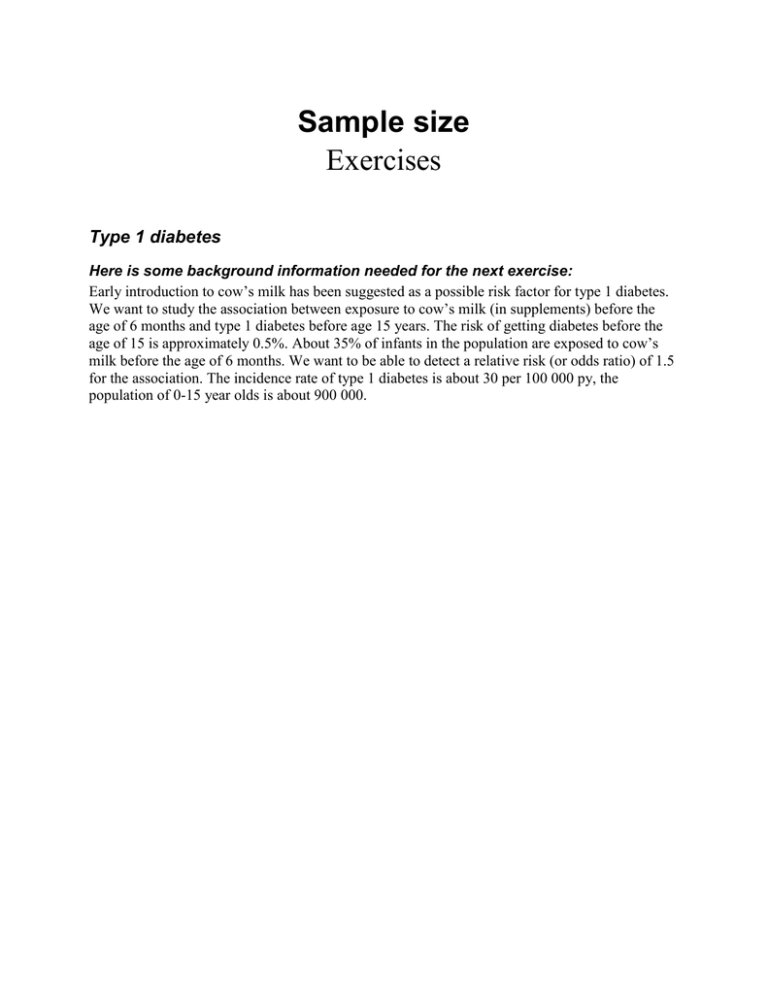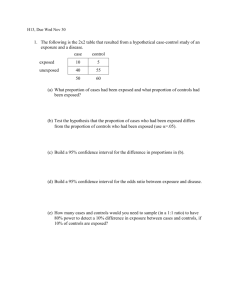Sample size Exercises Type 1 diabetes
advertisement

Sample size Exercises Type 1 diabetes Here is some background information needed for the next exercise: Early introduction to cow’s milk has been suggested as a possible risk factor for type 1 diabetes. We want to study the association between exposure to cow’s milk (in supplements) before the age of 6 months and type 1 diabetes before age 15 years. The risk of getting diabetes before the age of 15 is approximately 0.5%. About 35% of infants in the population are exposed to cow’s milk before the age of 6 months. We want to be able to detect a relative risk (or odds ratio) of 1.5 for the association. The incidence rate of type 1 diabetes is about 30 per 100 000 py, the population of 0-15 year olds is about 900 000. Exercise 1: Cohort versus traditional Case Control Below are sample size calculations for the study of cow’s milk on type 1 diabetes (based on a sample size calculator found at http://folk.uio.no/heins/Utilities/Utilities.html ). The first is a cohort study, the second a traditional case control study. Cohort study: Values 40 000 0.5 % 35.0 % 1.50 95 % 80 % Number of subjects, N= Proportion with disease= Proportion exposed= Expected OR= Confidence level: Power: Names Diabetes Cow-milk Diabetes Cow-milk + - Proportion exposed= Decimals= 2 2 + - 89 111 13 911 25 889 200 44.6 % 39800 35.0 % Proportion with disease 14 000 0.6 % 26 000 0.4 % 40000 0.5 % 35.0 % OR=1.5, 95% CI=(1.01 , 2.24) RR=1.5, 95% CI=(1.01 , 2.23) Traditional case control study: Cases: Controls per case: Proportion of cases exposed: Proportion of controls exposed: Expected OR: Confidence level: Power: Values: Names: 400 Diabetes 1.0 <- Choose one of the numbers to be <- calculated by the program, and <- write in values for the other two The proportion of cases exposed is calculated by the program 35.0 % 1.50 95 % 80 % Diabetes Cases Controls Cow-milk + - sum Proportion exposed= Decimals= 2 Cow-milk 179 221 140 260 400 44.7 % 400 35.0 % sum 319 481 800 39.8 % OR=1.5, 95% CI=(1 , 2.25), power=80% A case control study may be done with prevalent (existing) cases, or with incident (new) cases. The latter is preferable from a theoretical point of view (no survival bias), but may take some time. With an incidence of 30/100 000 new cases per year and a population of 900 000 youths we will have 270 new cases of diabetes per year. Questions: Discuss pros and cons for the two designs. 1. Explain the results of the cohort sample size calculation in words 2. Explain the results of the case-control sample size calculation in words 3. Compare the number of subjects in the two designs. 4. Compare the durations of the studies. There will be 3 durations: cohort, case-control with incident cases, and case-control with prevalent cases.





